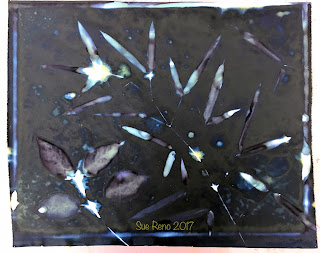With the last few days of moderate weather on the horizon, I went foraging in my yard once again for scraps of leaves to use in yet another round of wet cyanotype printing. I clipped some bamboo and a viburnum twig, above, and sweetgum, comfrey, and viburnum leaves, below.
The prints are on cotton sateen that I treated with cyanotype chemicals. Below are alpine strawberry leaves.
I used a bit of diluted washing soda sprayed around the edges of the cloth, before spraying the whole surface with plain water. Below you see the washing soda starting to work on changing the pH and breaking down the chemicals. The leaves are garlic mustard, an invasive nuisance, but one that's very handy for my current purposes as it sets new leaves in the late fall.
I put the prints out in bright sunlight for the short daylight hours. That night there was a hard freeze and the under surface of the glass covers got frosty. The bamboo print was the most dramatic:
(All images enlarge when clicked.)
The other ones looked pretty cool as well.
I brought them in at dusk on the second day. Again, these late season prints are not as dramatic and colorful as the ones from high summer, but they are still fascinating. Here are the un-rinsed prints:
Lots of dark mysterious colors.
The garlic mustard print looked amazing at this stage. I love the orange in the corners, but most of all I love that some of the delicate and intricate leaf patterning transferred to the print.
I have no way of knowing for sure, because there isn't a control in this experiment, but I suspect that the hard freeze added to this effect. This is just beautiful! A lot of the patterning inside the leaf shapes typically rinses out, because it hasn't been directly exposed to the UV rays of the sun, so I'm glad I take pictures and document this ephemeral stage.
And here are the finished prints:
Once again, I'm very happy with the results. I never quite know what I'm going to get with this process, but it's almost always interesting.
These alpine strawberry leaves are going to look great with some added stitching.
Best of all, a bit of the patterning remained in the garlic mustard prints.
Here's a detail. It's so pretty!
Now I really want to try another frozen exposure.
If you are new here, welcome! I've been detailing and documenting my experiments with wet cyanotype in great detail; you can read it in reverse chronological order by clicking the Wet Cyanotype tab in the top header, or click here.
And a reminder that I also post on social media:
Facebook page:http://www.facebook.com/suerenostudio
Twitter feed: http://twitter.com/suereno
Tumblr: http://suerenostudio.tumblr.com
Instagram: https://www.instagram.com/sue_reno_studio/


















No comments:
Post a Comment